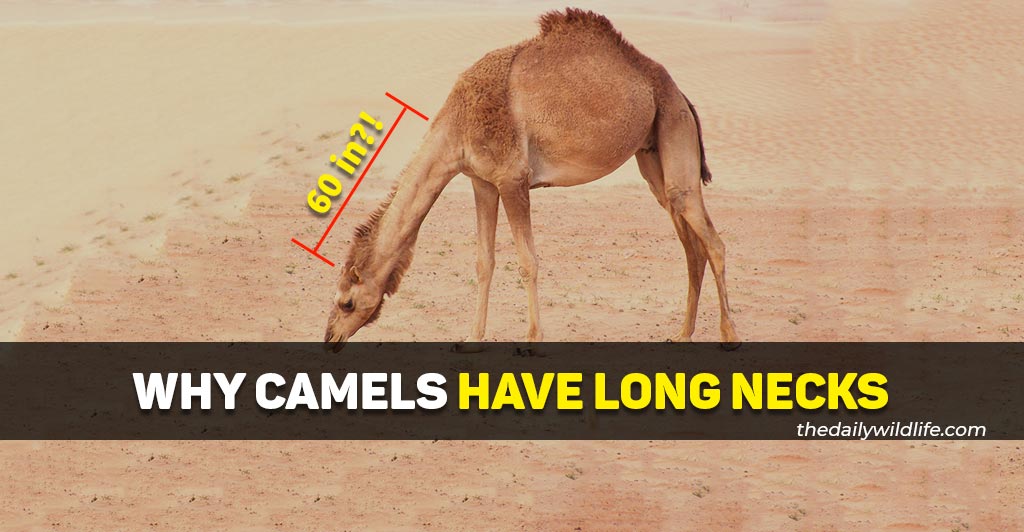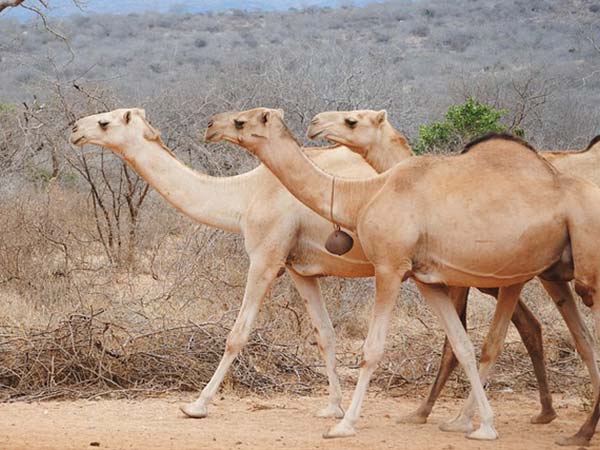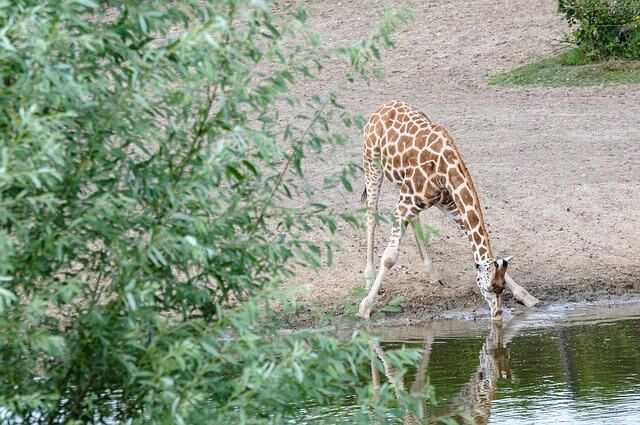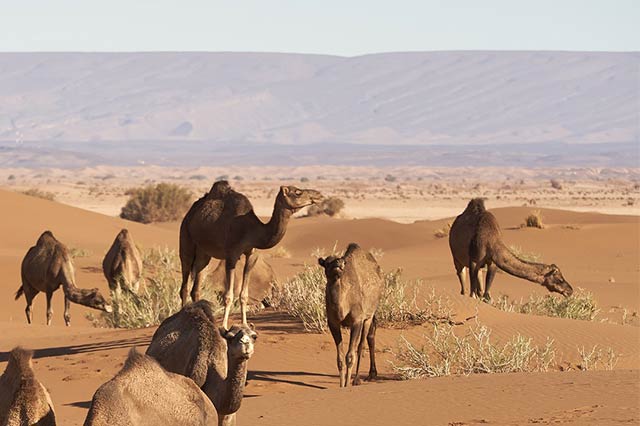A camel’s neck is an elongated part of the body that connects the head with the torso of the animal. Camels developed long necks to reach and browse food more easily, preserve energy and water, and notice approaching predators.
Their neck consists of several bones that support the head and allow the animal to move its head.
Compared to some other mammals, camel’s neck bones are larger and longer; this resulted in a greater length of the neck.
Here are all 3 reasons why camels have long necks explained in depth.

Table of Contents
Main Reasons Why Camels Have Long Necks
1. It Helps Camels Reach Food More Easily
Camels are herbivores that prefer to eat leaves, branches, and twigs from trees. A longer neck allows the camels to reach food that is over 10 feet above the ground (3m).
A camel is an animal that can use the best of two words, browsing and grazing.
It is not a very picky creature and will eat almost 80% of available plants in an area – plants other animals wouldn’t even smell.
However, that doesn’t mean they do not have their preference.
According to Kenyan camel herders, a camel would almost always prefer to eat leaves and twigs to grass.
And this is where their elongated necks come in handy.
They help the animal reach vegetation that is high on the trees and enjoy its preferred food.
Camel’s thin legs are around 60 inches long (153cm), and along with its neck, they play a role in reaching food and in saving water and energy.
2. Long Neck Helps Preserve Energy And Water
Because of their long and thin legs, camels had to evolve to reduce the energy required to move and operate. Having a longer neck saves energy required to lower the body down and reach the ground, makes the camel more stable, and helps save water.

If a camel had a shorter neck and wanted to reach the ground, it would need to bend its legs to do so.
Bending legs all the time would require a lot of energy and as a result, a camel would spend a lot more water.
And saving water is the most important thing for a camel.
It will close its nostrils to reduce water loss, it developed thick fur to prevent sweating, and among other things, it developed long and thin legs to walk.
Having big and muscular legs would make the camel move faster, but it would also increase the energy and water expenditure.
Also, thin legs that do not need a lot of energy to be moved, allow the camel to move more often from one tree to the other in a search of food.
All that energy that was saved on the legs can be used for moving the neck and reaching the food.
Also, long legs and necks allow the animal to get further away from the scorching desert sand.
This is very beneficial for the head, as it can be held at the optimal distance from the burning ground.
Also, their long necks allow them to keep a good balance when walking.
Camels will sway back and forth, especially when carrying a load, which will help them with stability.
3. Long Neck Allows Easier Scouting Of Predators
A camel’s long and curved neck, combined with its keen vision, allows the animal to quickly notice an approaching predator.
Whether a camel is sitting or standing, it can keep its neck and head up.
That gives it a better vision of the terrain in front and of any camel predator that is approaching.
Not just the size, but also the shape of their necks play a role in camels protecting themselves against predators.
For example, when a giraffe is drinking water, it will spread and bend its legs first and then lower its head to reach the water.

This puts the animal in a vulnerable position; its neck is slightly bent and the eyes are facing towards the water surface, and it is very hard for the animal to see who is approaching it and react quickly.
Camels, on the other hand, have slightly curved necks in the shape of the letter S.
This allows them to get down to the ground and reach food and water, but their head angle is such that they can see their surroundings a bit better.
Unlike the giraffe, they are not completely facing down as the extra length in their S-shaped neck allows them to do this.

Further reading: How closely related are camels and giraffes?
How Long Are Camel Necks?
According to camel scientists, camel necks are between 29.5 and 59.8 inches long (75-152cm), depending on the camel breed, age, and sex. Females have a neck length between 29.5 and 44.8 inches (75-114 cm), while males have between 33.4 and 59.8 inches (85-152 cm).
When it comes to camel neck girth (circumference), females range between 22.4 and 43.7 inches (57-111 cm), while males are between 21.6 and 46.8 inches (55-119 cm).
On average, males have a 12% longer neck, and 13% higher neck circumference, compared to females.[1]
Neck length is measured from the base of the head to the chest, while the neck circumference is measured at the middle of the neck.
Compared to horses, camels have a lot longer necks.
The average length of a horse’s neck is about 36 inches (91cm); this varies depending on horse size, breed, and age.
And compared to giraffes, who have a neck up to 70.8 inches long (1.8 m), camels have a shorter one.
An ostrich has a shorter neck, around 39 inches (1m), compared to a camel.
| Animal | Neck length |
| Camel | 59.8 in |
| Horse | 36 in |
| Giraffe | 70.8 in |
| Ostrich | 39 in |
| Human | 4.7 in |
Llamas have a lot shorter necks than camels. Read more about the llama’s neck in this article.
How Many Bones Are In A Camel’s Neck?
Similar to almost all mammals, there are 7 bones in a camel’s neck (C1-C7 vertebrae). They are called the cervical vertebrae and they provide mobility and stability to the neck and protect the spinal cord from injury.
Every bone is around 8 inches long (20cm) from the spine to the spine, except the first one.
The first bone of the neck (C1) is the smallest, and in Dromedary camels, the Atlas is around 2.62 inches long (6.67cm), and 5.9 inches wide (15 cm).[2]
The second vertebrae (C2), Axis, is the longest, 7.94 inches (20.17 cm), and the narrowest, 4.06 inches (10.33 cm).
When moving from C3 to C5, the length becomes shorter and decreases from around 7.08 inches (18cm) to 6.82 inches (17.33cm), while the width increases from 5.05 to 6.75 inches (from 12.83 to 17.17 cm).
The length and width of the sixth cervical vertebra (C6) of the camel are around 5.44 inches (13.83 cm).
The seventh bone (C7) was 4.65 inches (11.83cm) long and 5.18 inches (13.17cm) wide.
All of the bones of a camel’s neck are bound together by strong ligaments.
The neck muscles are also powerful.
Compared to other animals like an ox or a horse, the configuration and arrangement of cervical vertebrae in camels are similar.
However, the camel’s vertebrae are larger and longer.
When the camel is resting, the neck looks a bit swollen and slightly curved, and while it is walking the neck is curved and the head is raised a little above the shoulders.
When the camel wants to sleep, it will lower its neck and head and place them on the ground.
Read more about how and where camels sleep.
Camel With The Longest Neck
Aepycamelus or the long-necked camel is an extinct animal that had a characteristically extremely long neck, similar to a giraffe, and lived about 20 million years ago.
Aepycamelus major was the last and largest of the North American giraffe camels, with an estimated shoulder height of at least 13 feet (4 m) and a neck length of 5 to 6 feet (2 m).
Aepycamelus browsed in the open savannah of North America, where there weren’t too many trees, and is thought to be the first animal that developed pacing gait, the way modern camels walk.
Pacing gait, along with the long neck, allowed the animal to adapt better to its environment.
Final Thoughts
This concludes our article on the main reasons why camels have long necks.
Camels developed longer necks to help them reach higher vegetation, preserve energy and water when looking for food, keep a better balance when walking, and possibly notice approaching predators.
Their necks have 7 bones (cervical vertebrae), that are around 8 inches long. This allows the camel to have neck lengths between 29.5 and 59.8 inches (75-152cm), depending on the age and sex.
If camels didn’t have such long necks, they would probably be easier prey for predators and would not get as much food.
We hope you found the article interesting and that we managed to answer the question “why do camels have long necks” properly.
Read more: 10 Animals With Big Foreheads
References:
[1] Abdallah, H.R. & Faye, Bernard. (2012). Phenotypic classification of Saudi Arabian camel (Camelus dromedarius) by their body measurements. Emirates Journal of Food and Agriculture. 24. 272-280.
[2] Sharma, Anil, Jasvinder Singh Sasan, and M. R. Malik. “Morphometry of Cervical Vertebrae of Camel (Camelus dromedarius).” Indian Vet. J 90.1 (2013): 105-107.